Suppose you and your team have a new software idea, and you have discussed every aspect of its design, features, and technology. However, it is easy to overall a crucial part of your project, which is creating a technical requirement document. It is clear that if the instructions about the project aren’t clear, then the project never reaches its conclusion. Therefore, let’s learn about the importance, types, and how to create a technical requirements document.
What is a Technical Requirement Document?
A Technical Requirement Document (TRD) is like a blueprint that concisely conveys what you are trying to build. It ensures the whole team is on the same page with the product’s development in mind. In addition to that, it involves including the product’s features, functionality, and function in the technical requirement document template.
Moreover, this document also highlights the detailed outline plan of your project with the developer’s requirements, limitations, and objectives. The document also showcases the timeline, budget, scope of the project, and functional requirements. Present these instructions to the team using a diagram or visual aids to ensure a clear understanding and maintain a consistent workflow.
The Importance of Technical Specification Document
A technical specification document (TSD) lays the foundation of good business management as it keeps everything in one place. It benefits a software development company by reducing risks, maintaining team stability, and increasing productivity. That being said, let’s look at the key important aspects of a technical specification document:
- Clear Overview of Product: A specification document provides your team with a clear instructional plan about the product. The documents also include diagrams and pictures to ensure clarity among the team. This also unifies the developer and the team to be on the same page about the project.
- Risk Management: There are also chances of potential risks involved with the product’s development. Therefore, a technical specification document template indicates all the risk factors and provides strategies to reduce them.
- Proper Planning: In order to form the basis of your project, a company needs to form a proper plan. Therefore, a specification document gives the company an estimate of how much resources and budget they can spend on a project.
- Functionality of the Product: A product’s guidelines and functions are well recorded on a specification document. It gives engineers a clear image of the product’s features and functions to ensure it runs smoothly.
- Clear Communication: The document is a guideline and communication tool between the developer and the team. Provide them with subheadings, categories, and a roadmap outlining the project’s components to ensure collaboration.
Types of Technical Specification Document
There are various technical specification documents, each with a different purpose and specialization. Your team can utilize them depending on the scope of your projects. Following are the different types of technical specification documents that are tailored to your company’s needs:
1. Architecture Specification Document
As an engineer, creating an architecture specification document comprehensively describes the project. It involves a detailed description of all the work’s dimensions, workmanship, resources, and construction. Moreover, it benefits the team members to understand the layout of the whole operation with easy instructions.
2. Performance Specification Document
One of the types of technical requirements documents is the performance specification document, which provides the product’s overall performance. It usually focuses on the desired outcome, performance level, and standard to meet the intended objectives. You can provide a clear performance standard and ensure your users get the most experience from their product.
3. Software Technical Specification Document
Software companies use software technical specification documents to understand the application’s requirements. It can include the programming language, texting metrics, database scheme, and interface design of the software application. This helps users understand the outline of the software development process with detailed yet easy wording.
4. Product Technical Specification Document
The product technical specification document serves to comprehend the overall layout of a product’s specifications and its intended use. The document includes a detailed summary of the product, its functionality, and its features. Moreover, it guides users on how the development process and user feedback ensure that the final product meets all the user’s expectations and needs.
5. Usability Specifications Document
Another technical specification document example is a usability specifications document based on the user’s experience and feedback. Companies utilize this documentation to ensure that their product and software meets the customers’ needs. It includes user profiles, visual designs, product use cases by users, and many more. Additionally, it is intended to be used by various technical industries and developers.
6. Agile Technical Specification Document
An agile technical specification document presents an outline of the technical requirements necessary for agile development. It is constantly updated throughout the project development process to keep the document flexible and adaptable. Furthermore, this type of document embraces the changes based on user feedback throughout its development process. These documents provide a roadmap that delivers the best experience for the customers.
3 Examples of Technical Specification
Technical specifications vary across multiple industries as they require different outlining details, even for development, construction, or manufacturing. Let’s explore three technical requirement document examples across various domains.
1. AWS Specification Guide
The AWS technical guide is one of the top specification documents that provides users with thorough and detailed information. It serves as a comprehensive source to gather information on Amazon products’ capacity, specialty, and configuration. Moreover, it provides you with step-by-step guides, tutorials, SDKs, and code samples to help users how to install and deploy the product.
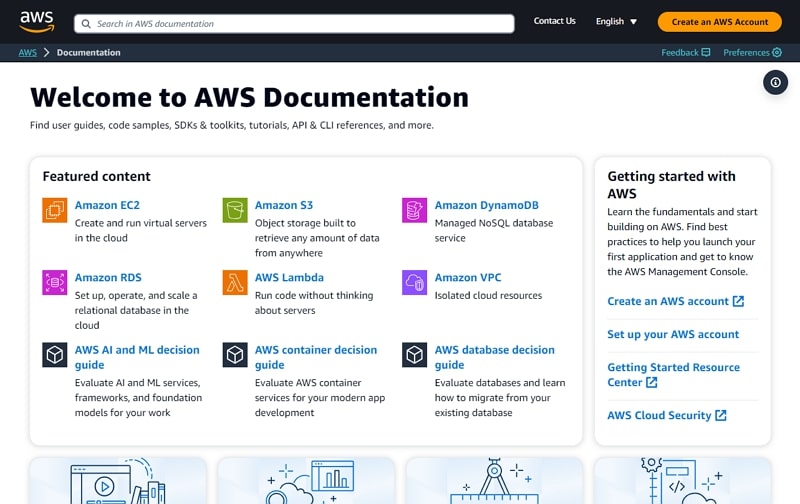
2. Tesla Manual for Owners
The Tesla owner’s manual is an excellent example of a technical requirement document that provides inclusive guidelines to Tesla owners. The manual covers all the features of a Tesla car, like its performance, features, and safety precautions. Furthermore, it covers battery life, advanced vehicle systems, and maintenance procedures so Tesla owners understand the car better.

3. Apple’s Developer Documentation Guide
Apple structures its documentation with detailed information and logic, making it easier for developers to find relevant knowledge. The guide covers many topics, from basic hardware specifications to advanced Apple features. Additionally, Apple consistently updates its manuals and documentation so that users can experience the latest product releases.
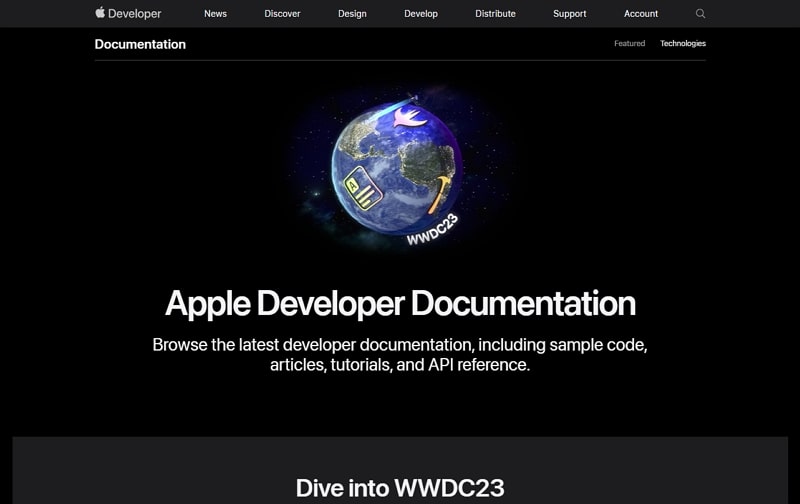
What to Do Before Writing Technical Requirements Documents?
It is crucial to understand the essential steps that are involved in the process of creating a technical requirement document. That’s why follow the steps on what to keep in mind before writing technical documentation:
- Understand Project Objectivity: It is essential to have an understanding of the overall objectives of the project. These objectives will help you create an outline that you can add to your technical document.
- Perform Research & Gather Information: To create resourceful documentation, do thorough research and gather relevant information. Moreover, this helps create a precise and up-to-date technical specification document.
- Comprehend Product’s Use: If you gather data and feedback from customers, then it lets you recognize how the product has been used. Therefore, it creates an overview of how you change the product, what to add, and suggests any future recommendations.
- Get to Know about Product Limitations: There are constraints and limitations in developing a product. This may include budgets, resources, lack of some features, or technical issues. Therefore, having a section for limitations can make your document more realistic.
How to Create Technical Requirement Documentation?
There are certain points to consider when creating a technical requirement document, and one should have certain skills to create relevant documentation. Therefore, let’s delve into the steps of creating technical documentation with the help of Docuo by Spreading.
Step 1: Create a Project by Accessing Docuo
You can log in to Docuo by using your Google Account, and after that, a new window will help you create a directory. Choose “Private Space” or a “Team Project” from the left-side panel to create your documentation. Afterward, click the “Create a Project” button on the top-right side of the screen and enter your project name. Then, hit the “Create” button to create technical requirements documentation using this AI-integrated tool.
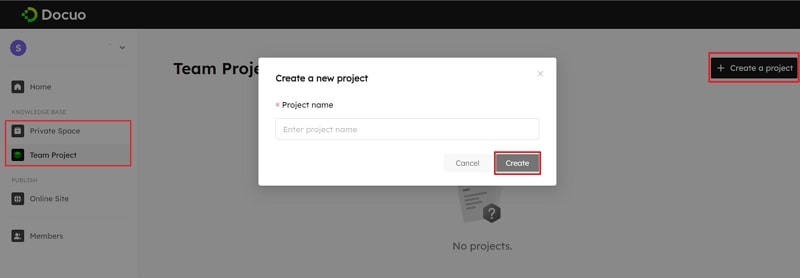
Step 2: Generate a Directory with AI
After creating your desired button, click the “AI” icon on the left-side panel to access the “Generate Directory with AI” pop-up screen. Here, you can choose the documentation type and the target audience and write the product description. After that, click the “Generate” button and then hit the “Apply” button to generate a directory from your technical requirement document.
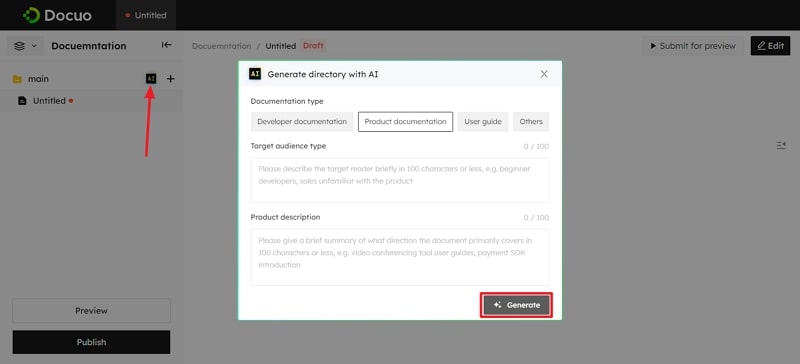
Step 3: Access Different Editing Options to Create the Document
Once the directory is created, the left-side panel will display the directory with different subcategories and headings. Choose any subcategory and click the “Edit” button on the top-right screen. By doing so, you will access the “Generate Outline” and the “Generate Doc from Code” options to create documentation.
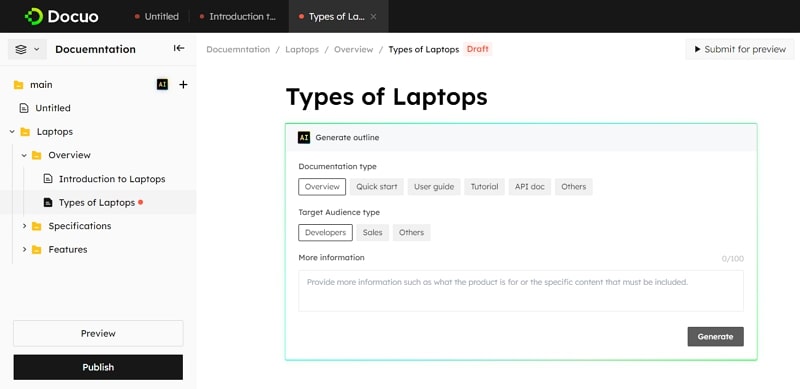
Step 4: Generate Technical Document with AI or Coding
In the outline option, you can write the documentation type target audience and add more information. At the same time, the coding option provides you with documentation type and coding space to generate technical documentation. You can also choose to preview your document from the left-side panel.
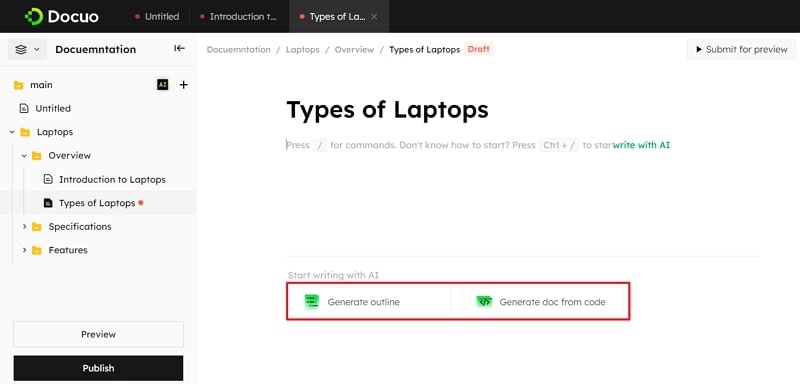
Final Words
In the end, a technical specification document is a detailed strategy that outlines the development of a project’s requirements, objectives, and limitations. It serves as a roadmap for the team in building the product to ensure everyone is on the same page. A technical specification is essential for the success of a software project and thus helps manage and reduce risk factors.
In addition, having a specialized tool to manage and create reliable documentation is necessary. That is why Docuo by Spreading is an excellent documentation software that utilizes various tools to help you effortlessly write technical documentation. Therefore, it elevates your team’s capabilities and eliminates uneven workflows with the help of this efficient tool.
Read more:


